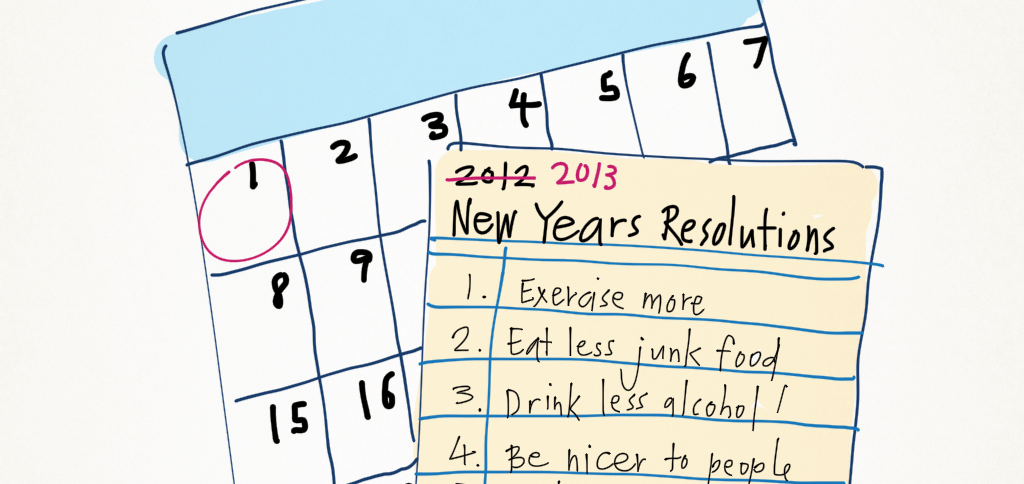Now that most people’s summer holidays have wound up and the office is looking a little less empty, it’s time to switch from thinking about your personal goals to thinking about your professional goals. Here are 13 UX Resolutions to help you set goals for the year ahead.
1. Listen more often to your users
If you currently get user feedback monthly, strive for weekly. If you already get feedback weekly, strive for richer feedback, and wherever possible supplement your existing research channels with direct observation. And remember: No time? No money? No excuse!
2. Seek more peer feedback
Whether you’re the most senior UX designer or the most junior UX Designer in your organisation, receiving peer feedback on your work can be intimidating, but it needn’t be. Approach feedback session with an open mind—you’ll be pleasantly surprised with what you’ll learn.
3. Take your headphones off once in a while
It’s important to focus on the task at hand when you’re busily designing the next best thing, but it’s also important to know what else is happening in the office around you. Don’t miss the opportunity to be drawn into important conversations by giving the appearance of being aloof and internally focused.
4. Get out of the office
It’s difficult to empathise with your users from the relative safety of your office cubicle, and very easy to put your head down and get lost in the details for weeks on end. Make the effort to get out of the office each day to take a stroll, have a meeting in a local park or café, or take a phone call. You’ll walk back into the office refreshed.
5. Find a new mentor (or mentee)
Most New Year’s Resolutions are about self improvement, so find a local mentor who can help you to reach the next level, and strike up a relationship with them. Don’t feel limited to finding a UX mentor within your own department either—great mentors may be found in other areas of the business, or external to your organisation.
6. Get more involved in your local UX community
Your local UX community can be a great source of support and inspiration. You’ll meet like-minded people and make life-long friends who share the same passions and face the same challenges as you. And if you don’t have a local UX community? Start one!
7. Give your own feedback
How great would it be to receive a constant flow of unsolicited feedback on your own product or service? Well, you have the power in your own hands to provide feedback on the products and services you use. And don’t feel limited to negative feedback—the positives are always nice to hear too.
8. Participate in non-digital experiences
We all download the latest apps and sign up to try the latest services, but there is still much to be learned from the way experiences (both good and bad) are crafted in the non-digital world too. Listen carefully for experiences that your friends rave (or rant) about, experience them for yourself and work out what makes them so good (or bad).
9. Try a new UX technique
Always wanted to run a diary study? How about a Collaborative Design Workshop? Pick a technique or two that you’d like to try, do a little research, then keep an eye out for an opportunity to give it a go.
10. Learn a new tool
It seems every other month a new UX tool becomes available. You’ll be surprised how energising it can be to start using a new tool, and just how fast you can pick it up and become proficient. There’s a great list of over 100 UX Tools in the Resources section of the UX MAstery site.
11. Think beyond the UI
It’s an easy trap to fall into, and we’ve all been there. The Ui is still the ‘sexy’ part of the output for many of your key stakeholders—many will still adhere to the old UX = UI adage. But if you can find the time to think beyond the UI, your users will thank you.
12. Take part in strategy discussions
Find out who the key strategic thinkers are in your organisation and invite yourself to the table. You may need to do some prep work first by sharing key user needs and UX insights, but you’ll be rewarded by having a chance to effect strategic roadmaps and product directions—all of which will be well worth the effort.
13. Design something you can be proud of
There’s nothing worse than looking back at a large body of work and not seeing anything you are particularly proud of. This year, take the time to document the big and small wins you make along the way. While it may seem at times you are drudging along, you’ll be pleasantly surprised if you keep track just how many things there are to be proud of over the course of a long year.
What other resolutions have you set yourself this year? Share them in the comments!



I think this is a refreshing post that touches on several great topics that are imperative for growth. I love the add regarding the non-digital space of learning as well as escaping a bit to refresh. All worth while in my book. Great Advice…
Duke
Thanks Antonio, inspiration from non-digital experiences is a particular passion of mine as I believe many people use everyday interactions as their experience yardstick, particularly in the self service domain.